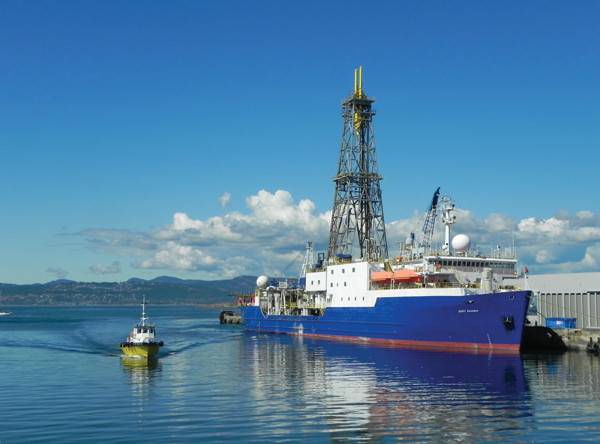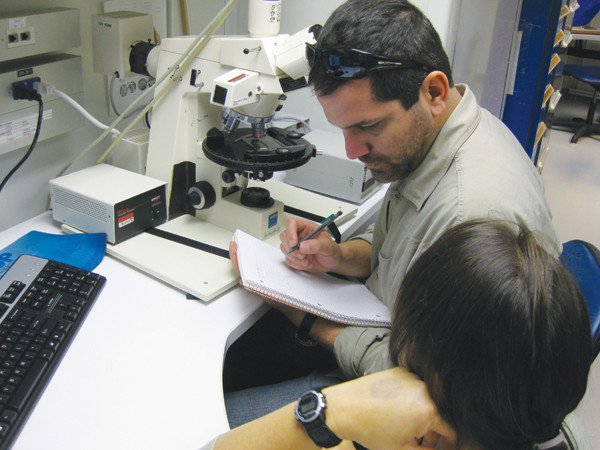
by John Van Hoesen Friday, July 20, 2012

Most of the School of Rock expeditions are aboard the IODP's ship, the JOIDES Resolution, pictured here at dock in British Columbia. John Van Hoesen

School of Rock participant (and author) John Van Hoesen records smear slide data. Sabreena Kasbati, Aquarium of the Pacific, USA & IODP
Many things come to mind when you hear the words “School of Rock”: a bad Jack Black flick, the middle school band you were in, the guitar school down the street from you, some pun about geology … yes, all are likely candidates. But the one I’m thinking of probably didn’t cross your mind. The School of Rock I had the privilege to attend is a professional development opportunity for educators to spend a week to 10 days at sea, learning about ocean drilling, how science is conducted on a yawing ship, and how to be better science teachers.
The School of Rock (SOR) program is run through the Integrated Ocean Drilling Program (IODP), supported by the National Science Foundation and coordinated by Deep Earth Academy, a program of the Consortium for Ocean Leadership. Since 2005, there have been eight SOR experiences: five aboard the IODP’s deep-sea drilling vessel, the JOIDES Resolution, and three at the IODP repository at Texas A&M University in College Station. Over the years, close to 100 people have participated in the program.
The objective is to educate participants about IODP, ocean drilling and earth science through hands-on experience, interaction with expedition scientists and technicians, and formal instruction by science team members from previous expeditions. Each SOR expedition has its own science goals as well.
I participated in SOR 2010 on IODP Expedition 328, which sailed out of Victoria, British Columbia. I joined 16 other educators with varying backgrounds in formal and informal education: high school teachers, museum educators, media experts and college instructors.
As we left port in Victoria, we sailed into the Pacific Ocean over the Juan de Fuca Plate, which is blanketed with a thick layer of sediments being scraped off the plate as it subducts under North America. This wedge of sediments is called the Cascadia accretionary prism and it holds an abundance of gas hydrates, in which gases, like the powerful greenhouse gas methane, are trapped in “cages” of water molecules.
As our journey began, we were all awed by the sheer size of the ship, an engineering marvel that is one of only two deep-ocean drilling vessels dedicated solely to marine research (the other being the Japanese-funded Chikyu). None of us had ever been aboard a drilling ship before. But we were even more awed once we started the scientific part of the expedition.
The science mission for Expedition 328 was to install an Advanced Circulation Obviation Retrofit Kit (ACORK) — a long-term deep-ocean observatory that will record temperature and pressure and sample in-situ pore fluid in Cascadia sediments in real time over the next decade.
The primary reason for installing an ACORK at this location is to develop a better understanding of in-situ pressure dynamics, pore-water characteristics, and the influence of pore-water migration on the accumulation of gas hydrates. Warming ocean temperatures or seafloor movement from an earthquake or landslide, for example, could release large quantities of methane gas rapidly, which could affect global climate and trigger landslides that can cause tsunamis.
Aboard ship, the SOR instructors had selected a variety of cores for us to characterize and interpret using the same techniques employed on a typical expedition. The cores ranged in composition from deep-ocean sediments rich in terrestrial dust to shallower-basin sediments collected along passive and active margins with a diverse offering of microfossils such as foraminifera and diatoms. After we identified and described the sediment and microfossils, we were asked to hypothesize which ocean basins they could have been collected from — as a way to link cores with geography and variations in ocean temperature.
SOR is organized like a traditional school day. Our “principal,” biologist Jennifer Collins with the Consortium for Ocean Leadership, tirelessly shepherded us through our 10- to 12-hour days. Daily activities included lab work focusing on sediment core chemistry and microfossil content (so we could better understand the characteristics of cores taken from different ocean basins and link chemistry and sediment variations with climate change), a variety of ship tours ranging from the engine room to the drill floor (which illustrated the technical and logistical challenges of drilling in deepwater), and evening presentations and group discussions about the nature of science, different approaches to teaching science, as well as conversations with expedition scientists.
We were also given time each day to reflect on what we had learned and how we might transfer our experiences to various educational settings. Whether it was exploring how the science of ocean drilling could be developed into an activity for high school or college students, brainstorming how it could be presented to a museum audience, or exploring online educational media, we tapped into each other’s unique expertise to assimilate how we could share this experience with others.
Many participants engaged in online educational outreach by posting reflections and expedition updates on the JOIDES Resolution blog (http://joidesresolution.org/blog), while others created videos of ship activities and interviewed the expedition scientists. A number of participants also communicated via video conference with home institutions so that students in their classes could talk directly with the expedition science crew.
Over the course of eight days, the shared multimedia folder created by the ship’s IT staff to foster collaboration ballooned to 40 gigabytes. The multimedia included video, audio interviews, photos and documents summarizing our personal experiences, reflections on how we each might integrate aspects of the science into our curricula, and a plan outlining what type of educational product we each hoped to develop post-expedition.
Many of the resulting products came to fruition over the last year and include a new edition of the JOIDES Resolution comic book series “Tales of the Resolution,” a new School of Rock promotional video, a virtual interface for exploring sediment smear slides, a public lecture for audiences throughout the United Kingdom, and numerous essays and workshops focusing on the scientific endeavors of the IODP and the ship.
Many of these post-cruise products were the result of collaborations among the participants. One of the most rewarding aspects of the SOR experience was that it fostered new relationships among professional colleagues, which then evolved into wonderful personal friendships. Cruise participants later collaborated on manuscripts, poster presentations, and workshops for the Deep Earth Academy at a variety of schools and conferences.
In addition, we all developed a better understanding of deep-sea core retrieval, tool installation, and the science that takes place before, during and after an expedition — which itself could be a metaphorical platform for developing creative ways to explain the science behind the drilling program. Since returning from sea, I have integrated my SOR experience into a number of courses, including introductory geology and climate dynamics.
I also decided to create a Web-based interface that incorporates high-resolution scanned sediment cores and gigapixel imagery of smear slides containing various microfossils and sediments. My goal was to create a virtual SOR experience through which educators and students could describe the overall characteristics of a core and its sediments to make inferences about depositional environments and potential links with historical climate change.
For those for whom the virtual experience is not enough, future SOR programs will be announced on the Deep Earth Academy and JOIDES websites listed above. It is a program I would encourage earth science educators at any level or institution to consider. You will return to work energized and filled with new knowledge to share with your students, visitors or audience.
© 2008-2021. All rights reserved. Any copying, redistribution or retransmission of any of the contents of this service without the expressed written permission of the American Geosciences Institute is expressly prohibited. Click here for all copyright requests.